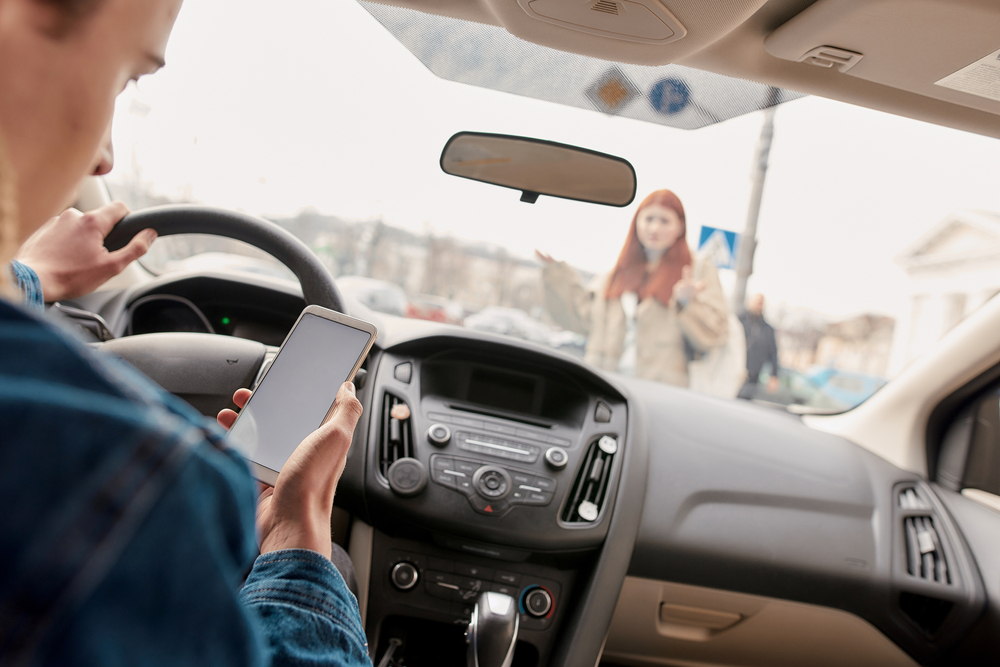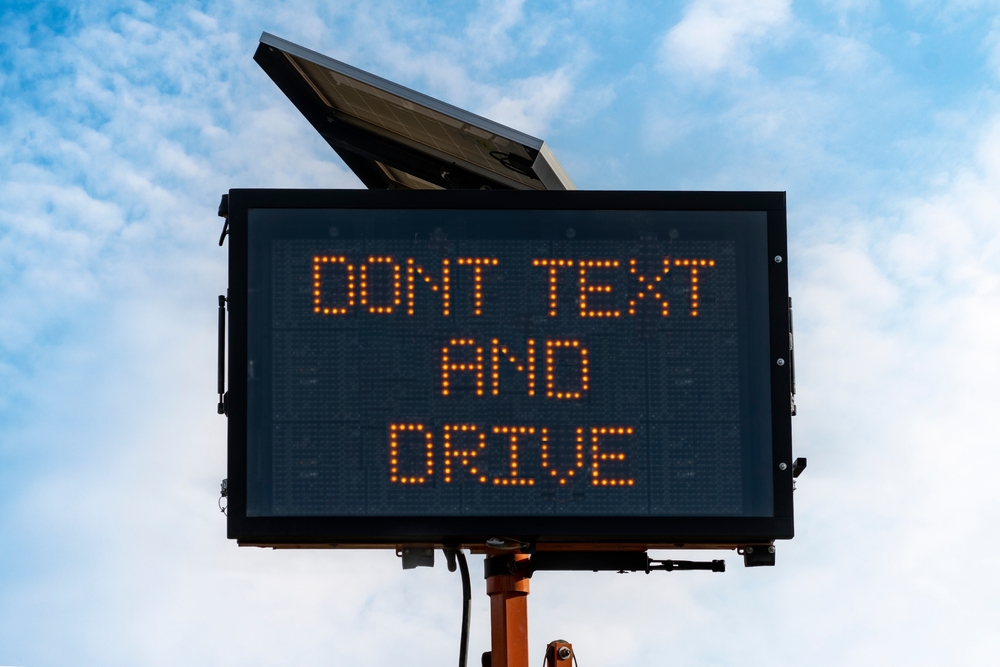
07 Sep Distracted Driving Laws in California and Their Impact on Accident Claims
Distracted driving laws are meant to discourage drivers from engaging in behavior that puts others at risk. This is crucial because the risks of unsafe driving are grave: For example, there were 4,285 traffic fatalities in California throughout 2021.
All car accidents can potentially cause serious injuries or death, and those wrecks caused by a distracted driver are no different. To reduce the number of individuals injured or killed by distracted drivers, California has implemented strict laws related to distracted driving.
This means that if you are driving while distracted in California, you can expect to receive a ticket and have to pay a fine. However, the impact of being cited for distracted driving goes beyond this. If an injury or fatality occurs in an accident involving distracted driving, the distracted driver may face legal liability through an accident claim.
It is important for California drivers to know how distracted driving laws impact accident claims in the state.
What Is Distracted Driving?
To understand distracted driving laws in California, it is helpful to first learn what counts as distracted driving. When you are behind the wheel, you are considered distracted if your eyes, mind, hands, or feet are kept from being fully engaged with the task of driving. Such distractions could include:
Distractions of the Eyes
You could be occupied looking at a device or elsewhere besides the road in front of you and the traffic around you. Cell phone screens, your dashboard in your car, a map, a newspaper, or something happening outside of your vehicle could all draw your attention from the task at hand.
When your eyes are distracted, they cannot scan your surroundings for dangers as well as they otherwise could. The result is that it takes you longer to see hazards and react to them. In some cases, you may not see a hazard like a bicyclist or pedestrian until after a collision.
Distractions of the Mind
Distractions of the mind leave you thinking about something other than what you are doing at that moment in the car. Any wayward thoughts can be a distraction, such as thinking about what you must do when you get to work or when you get home.
A distraction of the mind could also be a telephone or text conversation that you are having. You are not fully engaged with what is happening around you because you are attempting to keep up with that conversation.
When your mind is occupied with thoughts other than those pertaining to driving, it can take you longer to react to events and circumstances on the road. You may not realize that traffic is stopped or that there is an object in your way until your mind snaps back from the distraction to the present moment. By then, it can be too late to avoid a crash.
Distractions of the Hands and Feet
There are also distractions that occupy your hands and your feet and keep them from being able to safely manipulate your car’s gas pedal, brake pedal, and steering wheel. You may be completely aware of what is going on outside your car. However, if your hands and feet cannot safely control your vehicle, it is difficult to avoid a crash.
You might be one of those drivers who applies lipstick and makeup on your way to work. Or maybe you place calls, return text messages, or eat breakfast while you are behind the wheel.
These are all distractions that interfere with your hands’ ability to control your car. Similarly, taking your shoes off while driving and leaving your shoes on the floor near the gas and brake pedals can interfere with your feet’s ability to use those pedals.
Distractions can fall into multiple categories. For instance, texting while driving is a distraction that affects your eyes, mind, and hands. You are focused on the screen and trying to keep up with the conversation while you attempt to type out your response to the other person. It is for this reason that authorities advise, “Don’t text and drive.”
Distracted Driving Statistics
Texting and driving statistics demonstrate the extent of the distracted driving problem in California. According to the California Highway Patrol, between October 2021 and September 2022, the agency issued over 57,000 citations for cell phone violations while driving.
The Highway Patrol’s texting while driving statistics also showed that 9,733 people were hurt and 96 people were killed as a result of distracted driving in 2022 alone.
Distracted Driving Laws in California You Should Know
Not every state has laws specifically about distracted driving or using a cell phone while behind the wheel. However, California is one of the few states with several laws addressing distracted driving.
First, these laws state that you may not hold or use a cell phone while actively driving. This law applies whether you move in traffic or stop at a light. You can only use your cell phone if you can do so using hands-free voice commands.
Additionally, this law is expansive and applies to more than talking and texting. Aside from being able to use one hand to turn on or off a phone’s GPS functioning, nearly every other task you could do on your phone must be done hands-free if you are driving.
If your child is under 18, then the law is even stricter when it comes to using cell phones behind the wheel. Minor children are prohibited from using a cell phone while driving for any purpose, even if they do so in hands-free mode. The only exception to this blanket prohibition is if the minor uses the phone in an emergency.
Drivers who violate these laws can be issued a ticket and fined. In addition, they can find themselves with points added to their license. Beyond this, if they are involved in a motor vehicle crash that injures or kills another person, the distracted driver could also be civilly liable.
Such liability could include paying damages to others who were hurt or the families of those killed in the accident.

How Distracted Driving Impacts California Motor Vehicle Injury Claims
Every state chooses to be either an at- or no-fault auto insurance state. The key difference between being an at-fault state and a no-fault state involves who is responsible for paying compensation to injured parties after a car accident.
No-Fault Insurance Explained
In a no-fault state, each person injured in a car accident is responsible for their injuries and the associated costs. In these states, compensation does not depend on proving who caused the crash. If you are hurt in a no-fault state, you submit a claim to your insurance carrier, and your insurance company pays your claim.
If you live in a no-fault state and are hurt in a wreck, you can expect to have your insurance claim paid quicker than in an at-fault state. However, you are likely to pay more for your insurance coverage.
And if your insurance does not cover all of your losses, your right to bring a lawsuit against the at-fault driver for additional compensation is limited.
California Is an At-Fault Insurance State
California follows the majority of states in that it is an at-fault car insurance state. As an at-fault state, the driver who caused a wreck through their own negligence pays for the damages the accident causes to you and others.
In most cases, the responsible party’s insurance policy will cover your expenses and damages. When the policy’s benefits are insufficient, you can usually hold the at-fault driver responsible for any difference.
You are more likely to receive damages that fully address your expenses and losses in an at-fault state. However, receiving this compensation requires you and your attorney to gather and present evidence that the other driver was responsible for causing the wreck.
Distracted Driving Can Create Legal Liability for a Driver
In an at-fault insurance state like California, a driver who was texting while driving can be found to be responsible for causing a crash. If evidence shows that the driver was engaged in distracted driving and that such actions caused or contributed to your crash, then that driver can be ordered to pay you compensation.
This is because distracted driving is generally considered negligent behavior. So, your evidence would need to show that the other driver’s distracted driving was more likely than not a cause of the accident.
Because California is a pure comparative negligence state, a driver who was texting while driving could be responsible for paying some damages even if there were other causes of the crash.
How to Prove Distracted Driving
When your lawyer investigates the circumstances of your crash, they will likely look for evidence of any distracted driving, since it is a common factor in many California accidents. There are a number of sources of evidence that could indicate an at-fault driver was distracted at the time of your wreck, including:
- The driver’s statements admitting that they were distracted
- Observations of witnesses who saw the driver using their cell phone
- Evidence inside the driver’s car, such as a cell phone that is turned on
- Cell phone records from the driver’s cell service provider, which can show when texts and phone calls were made
With any evidence that suggests distracted driving took place, it is critical to take prompt steps to locate and preserve that evidence. Witness memories can fade and become uncertain as time passes. Similarly, records from cell providers and other documentary evidence can be lost if too much time passes.
Time Limitations on Filing a Distracted Driving Lawsuit
Like other motor vehicle injury claims in California, the state’s statute of limitations allows you to file a claim for compensation up to two years after the crash. For purposes of the statute of limitations, it does not matter what caused the crash or even whether distracted driving was a contributing factor.
Because the statute of limitations begins on the day of your accident, it is advisable to seek legal help immediately from a local car accident lawyer. It is not uncommon to file your claim without fully knowing whether the at-fault driver was distracted just to meet the statute of limitations.
Further investigation can either confirm or deny whether distracted driving was a factor in your case.
A Seasoned Car Accident Attorney Can Handle Your Accident Claim
When you have been injured in a car wreck in California, understanding how your accident happened and who is responsible is paramount. Compensation may be available for your injuries, medical bills, and other losses, but only if you can bring a successful claim against the at-fault or distracted driver.
With years of experience successfully representing motor vehicle accident victims hurt by distracted, drunk, and aggressive drivers, the dedicated team of Oroville car accident lawyers at Steve Gimblin Personal Injury & Car Accident Lawyer can also help you. Our firm is well-equipped with the knowledge and resources needed to investigate and support your claim, and we are committed to fighting on your behalf for justice and fair compensation.
You only have a limited amount of time to hold a distracted driver accountable for the harm they cause you. Don’t wait to turn to experienced and knowledgeable legal assistance. Contact the Steve Gimblin Personal Injury & Car Accident Lawyer today.




No Comments